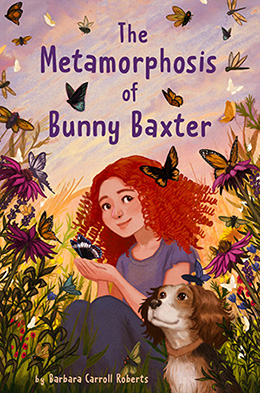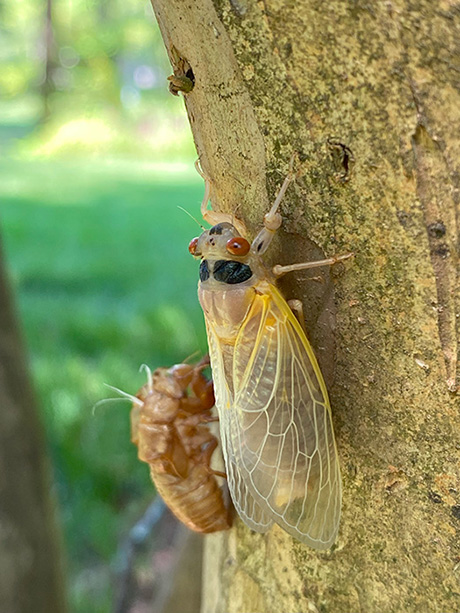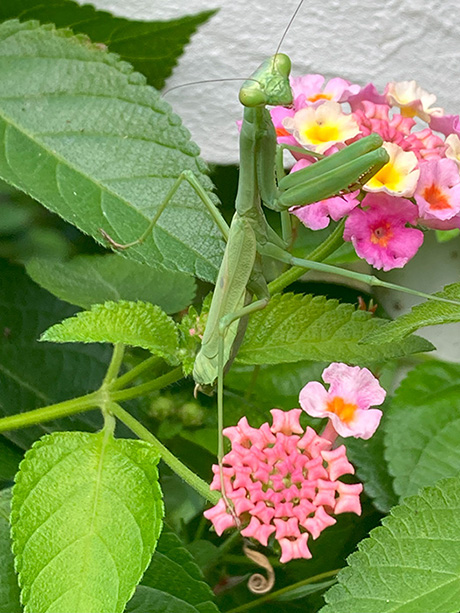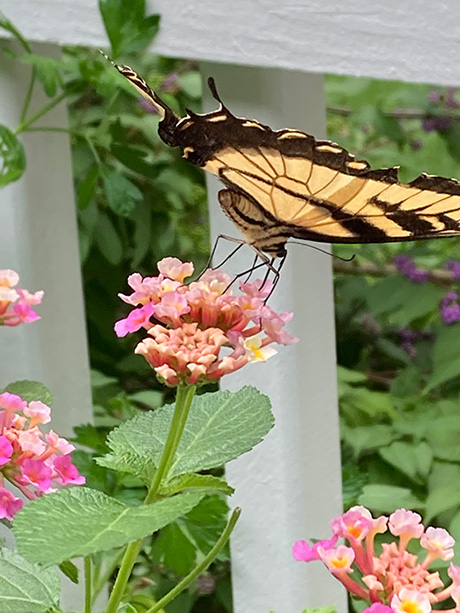The Metamorphosis of Bunny Baxter

Bunny Baxter thinks nothing could be worse than starting seventh grade at a school where she knows no one. But after her first day, she realizes things can actually get much worse.
If Bunny Baxter were an insect, she’d have so many ways to slip through seventh grade unnoticed. But she’s tall instead of tiny, has flaming red Medusa hair instead of camouflage, and she suffers from social anxiety, which makes it hard to be part of a swarm. Worst of all, she’s been redistricted to a new middle school away from her best friend who she could always hide behind when her anxiety got the best of her.
The first day at E.D. Britt Middle School does not go well. Bunny trips on the steps, falls into the cutest boy in the school, and causes a kid domino pile-up. At lunch, she unintentionally causes an uproar in the cafeteria, which lands her and another girl in the principal’s office. Bunny decides there is only one option: to get expelled so she can transfer to the school her best friend attends.
She soon discovers that it isn’t that hard to get in trouble — don’t turn in your homework, walk around the track instead of run in P.E., pretend you deliberately hit someone with a badminton birdie. What isn’t so easy for Bunny is realizing she now has a reputation as a troublemaker. And even more confusing, when it looks like her plan to get expelled might work, she’s no longer sure what to do.
The Metamorphosis of Bunny Baxter is a heartfelt coming of age story about an insect-loving girl who is learning to grow into herself — quirks and all.
Recognition
Junior Library Guild Gold Standard selection
Resources
- Teachers’ Guide for The Metamorphosis of Bunny Baxter (downloadable PDF)
- “Growing Up and Stuff,” a guest post with Amanda MacGregor on Teen Librarian Toolbox, School Library Journal, 23 July 2025
- “Author Spotlight: Barbara Carroll Roberts,” interview on From the Mixed-Up Files … of Middle Grade Authors, July 2025
Reviews
“Because of school redistricting, shy Theodosia “Bunny” Baxter starts seventh grade at a different middle school than her best friend Alex. Practicing deep breathing techniques to calm her nerves, the redheaded, bug-loving tween attempts to go unnoticed (like “a tiny, tiny ant”) but gains notoriety on her first day due to separate incidents involving a cute boy named Kyle and Paige, a bully who mockingly dubs her Bug Eater and wonders aloud about Bunny’s feelings around being adopted. While relaying woes about mean peers to her father, his offhanded comment — “kids with discipline problems can be sent to an alternative school”—inspires Bunny to concoct a plan: she’ll get herself expelled, mistakenly believing that she’ll be transferred to Alex’s school. Bunny soon dedicates herself to troublemaking, even as she starts making new friends. This heartfelt tale by Roberts (A Rose Named Peace) — distinguished by a distinctive, layered cast with authentic-feeling motivations and relationships — nimbly explores subjects such as the ecological importance of pollinators alongside a fine-tuned emotional exploration of adoption.” (Publishers Weekly, starred review)
A nature-loving seventh grader starts school determined to be kicked out as soon as possible.
Thanks to her great mop of flaming-red hair and some unfortunate incidents on the first day, Theodosia “Bunny” Baxter’s hopes of invisibly blending in at her new middle school may be dashed. But the ensuing notoriety leaves her alternative scheme—being expelled, so she can go to school with her best friend—all the more doable. Or so she thinks. As it turns out, she’s not very good at bad behavior, among the many endearing qualities that will draw readers to her. Bunny fumbles her way toward successfully coping with many things, including bullying, pressure to sign up for an athletic competition, complex feelings about being adopted, and anxiety attacks that manifest in part as serious rashes. Roberts tucks engaging classroom activities into this already thematically robust tale—like the fizzy social dynamics in an experimental initiative-building class called Discoveries, the ins and outs of creating a garden of native plants, and tagging monarch butterflies—as she artfully tracks a profound transformation in her protagonist’s sense of self. The changes may be Bunny’s doing, but she’s helped along by a generously sized cast of almost uniformly supportive adults and peers (plus one great dog). By the book’s buoyant end, even one prickly girl’s repeated insistence that she’s not Bunny’s friend is sounding hollow. Bunny is cued white, and there’s some racial diversity in the supporting cast.
Sweet, smart, and sensitive. (Kirkus Reviews)
“Sometimes it feels like a miracle that we make it through middle school. It really does. And so it’s wonderful to have stories like this one as our companions — stories about making mistakes, losing and finding friends, disappointing our teachers and winning their respect, and feeling ourselves grow into the person we almost did not believe we could be. Read this. You’ll cheer for Bunny — and cry a bit too. And by the end, you’ll realize that she’s not the only one you’re cheering and crying for in these pages.” (Gary D. Schmidt, Newbery and Printz Honor Winner)
“You’ll cheer for Bunny Baxter in this spot-on middle grade in which Bunny uses her passion for pollinators to grow a garden, friendships, and her voice.” (Kathryn Erskine, National Book Award Winner)
“Just finished Barbara Roberts’ 2025 book, The Metamorphosis of Bunny Baxter. *Sigh* So many reasons to love this book: an insect-loving girl, intense middle school awkwardness, an unlikely friendship, a school project involving manure, an understanding dog … and one more reason which you’ll have to find out by reading the book. A terrific summer (or anytime) read!! (Joyce Sidman)
Behind the Book
When I was in graduate school, working on becoming a children’s writer, we had to write essays about different aspects of children’s books. One of the other students, a woman who’d been adopted into her family and who subsequently adopted her own children, wrote an essay about how few children’s books included a main character who’d been adopted. And of the few that she found, most of them focused on the character searching for a birth parent. This student felt that there should be more books about kids who’d been adopted. But more than that, these characters should have more stories.
That is, there should be more books in which the main character happened to have been adopted into their family, but the fact of their adoption was not what the book was about. These characters should have as many and as varied stories as anyone else.
Since my husband and I had adopted one of our children, I decided to take on this challenge. All I had to do was come up with a story. (No easy task for someone who writes as slowly as I do.)
But then I started thinking about a natural phenomenon that would soon occur where I live — the emergence of the seventeen-year cicadas. This is a massive brood of cicadas that live underground for seventeen years in larval form, and then all at the same time, tunnel up to the surface, climb the closest vertical thing they find — trees, bushes, lampposts — shed their last larval exoskeleton, and emerge as flying, singing, egg-laying adults. Millions and millions of them, all at once.

Many people find this phenomenon alarming or disgusting or simply way too loud, but I think it’s fascinating. So I decided to create a character who was equally fascinated by cicadas and incorporate the emergence of the seventeen-year cicadas into her story.
But as I was working on early drafts of this book, something else happened. The Covid pandemic hit, and schools closed to prevent the disease from spreading. Which meant that, in the spring of 2021 when the seventeen-year cicadas emerged here in Virginia, the kids in my book would be going to school online, not in their classrooms. My story — a great deal of which takes place at Bunny’s school — fell apart.

Fortunately, while researching cicadas I’d collected a big stack of books and articles about all kinds of insects. And as I learned more about them and their importance in our world, I realized that Bunny’s interest in insects could expand along with mine.
There are still cicadas in this book, but they’re the regular, annual variety that tunnel up from underground every summer. I guess I’ll just have to wait until 2038 to put the seventeen-year cicadas in a book.


Margaret Ferguson Books /
Holiday House, July 2025
ISBN: 978–0‑823–45856‑1
Middle-Grade Fiction
256 pages
Age Range: 9–14


